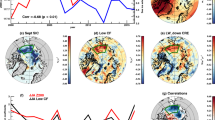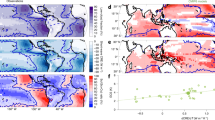Abstract
The extent of snow cover1 and sea ice2 in the Northern Hemispherehas declined since 1979, coincident with hemispheric warming and indicative of a positive feedback of surface reflectivity on climate. This albedo feedback of snow on land has been quantified from observations at seasonal timescales3,4,5,6, and century-scale feedback has been assessed using climate models7,8,9,10. However, the total impact of the cryosphere on radiative forcing and albedo feedback has yet to be determined from measurements. Here we assess the influence of the Northern Hemisphere cryosphere on Earth’s radiation budget at the top of the atmosphere—termed cryosphere radiative forcing—by synthesizing a variety of remote sensing and field measurements. We estimate mean Northern Hemisphere forcing at −4.6 to −2.2 W m−2, with a peak in May of −9.0±2.7 W m−2. We find that cyrospheric cooling declined by 0.45 W m−2 from 1979 to 2008, with nearly equal contributions from changes in land snow cover and sea ice. On the basis of these observations, we conclude that the albedo feedback from the Northern Hemisphere cryosphere falls between 0.3 and 1.1 W m−2 K−1, substantially larger than comparable estimates obtained from 18 climate models.
This is a preview of subscription content, access via your institution
Access options
Subscribe to this journal
Receive 12 print issues and online access
$259.00 per year
only $21.58 per issue
Buy this article
- Purchase on Springer Link
- Instant access to full article PDF
Prices may be subject to local taxes which are calculated during checkout


Similar content being viewed by others
References
Déry, S. J. & Brown, R. D. Recent Northern Hemisphere snow cover extent trends and implications for the snow-albedo-feedback. Geophys. Res. Lett. 34, L22504 (2007).
Serreze, M. C., Holland, M. M. & Stroeve, J. Perspectives on the Arctic’s shrinking sea-ice cover. Science 315, 1533–1536 (2007).
Groisman, P. Y., Karl, T. R. & Knight, R. W. Observed impact of snow cover on the heat balance and the rise of continental spring temperatures. Science 263, 198–200 (1994).
Hall, A. & Qu, X. Using the current seasonal cycle to constrain snow albedo feedback in future climate change. Geophys. Res. Lett. 33, L03502 (2006).
Qu, X. & Hall, A. Assessing snow albedo feedback in simulated climate change. J. Clim. 19, 2617–2630 (2006).
Fernandes, R. et al. Controls on Northern Hemisphere snow albedo feedback quantified using satellite earth observations. Geophys. Res. Lett. 36, L21702 (2009).
Colman, R. A comparison of climate feedbacks in general circulation models. Clim. Dyn. 20, 865–873 (2003).
Winton, M. Surface albedo feedback estimates for the AR4 climate models. J. Clim. 19, 359–365 (2006).
Shell, K. M., Kiehl, J. T. & Shields, C. A. Using the radiative kernel technique to calculate climate feedbacks in NCAR’s community atmospheric model. J. Clim. 21, 2269–2282 (2008).
Soden, B. J. et al. Quantifying climate feedbacks using radiative kernels. J. Clim. 21, 3504–3520 (2008).
Trenberth, K. E. & Fasullo, J. T. Global warming due to increasing absorbed solar radiation. Geophys. Res. Lett. 36, L07706 (2009).
Qu, X. & Hall, A. Surface contribution to planetary albedo variability in cryosphere regions. J. Clim. 18, 5239–5252 (2005).
Wielicki, B. A. et al. Changes in Earth’s albedo measured by satellite. Science 308, 825 (2005).
Robinson, D. A. & Frei, A. Seasonal variability of Northern Hemisphere snow extent using visible satellite data. Professional Geogr. 51, 307–314 (2000).
Cavalieri, D., Parkinson, C., Gloersen, P. & Zwally, H. J. Sea ice concentrations from Nimbus-7 SMMR and DMSP SSM/I passive microwave data, [1979–2008] (1996, updated 2008). Boulder, CO, USA: National Snow and Ice Data Center. Digital media.
Wang, X. & Key, J. R. Arctic surface, cloud, and radiation properties based on the AVHRR polar pathfinder dataset. Part I: Spatial and temporal characteristics. J. Clim. 18, 2558–2574 (2005).
Fowler, C., Emery, W. J. & Maslanik, J. Satellite-derived evolution of Arctic sea ice age: October 1978 to March 2003. IEEE Geosci. Remote Sens. Lett. 1, 71–74 (2004).
Maslanik, J. A. et al. A younger, thinner Arctic ice cover: Increased potential for rapid, extensive sea-ice loss. Geophys. Res. Lett. 34, L24501 (2007).
Perovich, D. K., Grenfell, T. C., Light, B. & Hobbs, P. V. Seasonal evolution of the albedo of multiyear Arctic sea ice. J. Geophys. Res. 107, 8044 (2002).
Tschudi, M. A., Fowler, C., Maslanik, J. A. & Stroeve, J. Tracking the movement and changing surface characteristics of Arctic sea ice. IEEE J. Sel. Top. Earth Obs. Remote Sens. 3, 536–540 (2010).
Barlage, M., Zeng, X., Wei, H. & Mitchell, K. E. A global 0.05° maximum albedo dataset of snow-covered land based on MODIS observations. Geophys. Res. Lett. 32, L17405 (2005).
Rossow, W. & Schiffer, R. Advances in understanding clouds from ISCCP. Bull. Am. Meteorol. Soc. 80, 2261–2288 (1999).
Qu, X. & Hall, A. What controls the strength of snow-albedo feedback? J. Clim. 20, 3971–3981 (2007).
Eastman, R. & Warren, S. Interannual variations of Arctic cloud types in relation to sea ice. J. Clim. 23, 4216–4232 (2010).
Kay, J. E. & Gettelman, A. Cloud influence on and response to seasonal arctic sea ice loss. J. Geophys. Res. 114, D18204 (2009).
Perovich, D. K., Nghiem, S. V., Markus, T. & Schweiger, A. Seasonal evolution and interannual variability of the local solar energy absorbed by the arctic sea ice–ocean system. J. Geophys. Res. 112, C03005 (2007).
Markus, T., Stroeve, J. C. & Miller, J. Recent changes in arctic sea ice melt onset, freezeup, and melt season length. J. Geophys. Res. 114, C12024 (2009).
Mote, T. L. Greenland surface melt trends 1973–2007: Evidence of a large increase in 2007. Geophys. Res. Lett. 34, L22507 (2007).
Hansen, J., Ruedy, R., Sato, M. & Lo, K. Global surface temperature change. Rev. Geophys. 48, RG4004 (2010).
Brohan, P., Kennedy, J. J., Harris, I., Tett, S. F. B. & Jones, P. D. Uncertainty estimates in regional and global observed temperature changes: a new dataset from 1850. J. Geophys. Res. 111, D12106 (2006).
Stroeve, J., Holland, M. M., Meier, W., Scambos, T. & Serreze, M. Arctic sea ice decline: Faster than forecast. Geophys. Res. Lett. 34, L09501 (2007).
Zender, C. S. et al. Atmospheric absorption during the atmospheric radiation measurement (ARM) enhanced shortwave experiment (ARESE). J. Geophys. Res. 102, 29901–29915 (1997).
Acknowledgements
We thank C. Fowler and J. Maslanik for providing multi-year sea-ice data, T. Estilow and M. J. Brodzik for providing snow and sea-ice data and advice, and S. Warren for reviewing the manuscript. MODIS data are distributed by the Land Processes Distributed Active Archive Center, located at the US Geological Survey Earth Resources Observation and Science Center (lpdaac.usgs.gov). The ISCCP D2 data were obtained from the International Satellite Cloud Climatology Project web site (http://isccp.giss.nasa.gov) maintained by the ISCCP research group at NASA Goddard Institute for Space Studies. We acknowledge the modelling groups, the Program for Climate Model Diagnosis and Intercomparison and the WCRP’s Working Group on Coupled Modelling for their roles in making available the WCRP CMIP3 multi-model data set. Research was supported by NSF ATM-0852775 (M.G.F.) and ATM-0904092 (K.M.S.).
Author information
Authors and Affiliations
Contributions
M.G.F. wrote the manuscript and combined all data sets to quantify CrRF. K.M.S. provided radiative kernel data, quantified CMIP3 model feedbacks and helped write the manuscript. M.B. provided land snow-covered albedo data. D.K.P. and M.A.T. provided, respectively, field-measured and remote sensing sea-ice albedo data.
Corresponding author
Ethics declarations
Competing interests
The authors declare no competing financial interests.
Supplementary information
Supplementary Information
Supplementary Information (PDF 2486 kb)
Rights and permissions
About this article
Cite this article
Flanner, M., Shell, K., Barlage, M. et al. Radiative forcing and albedo feedback from the Northern Hemisphere cryosphere between 1979 and 2008. Nature Geosci 4, 151–155 (2011). https://doi.org/10.1038/ngeo1062
Received:
Accepted:
Published:
Issue Date:
DOI: https://doi.org/10.1038/ngeo1062
This article is cited by
-
A cleaner snow future mitigates Northern Hemisphere snowpack loss from warming
Nature Communications (2023)
-
Unraveling the optical shape of snow
Nature Communications (2023)
-
Assessment of precipitation type discrimination methods on glacier of Qilian Mountains
Journal of Mountain Science (2023)
-
Using self-organizing maps to detect northern hemisphere cryo-cover transformation
Climate Dynamics (2023)
-
Irrigation and warming drive the decreases in surface albedo over High Mountain Asia
Scientific Reports (2022)



